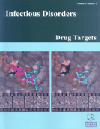- Home
- A-Z Publications
- Infectious Disorders - Drug Targets (Formerly Current Drug Targets - Infectious Disorders)
- Previous Issues
- Volume 15, Issue 2, 2015
Infectious Disorders - Drug Targets (Formerly Current Drug Targets - Infectious Disorders) - Volume 15, Issue 2, 2015
Volume 15, Issue 2, 2015
-
-
Hydrazones as a Privileged Structural Linker in Antitubercular Agents: A Review
More LessHydrazones are a versatile linker of connecting various classes of organic compounds with a unique structural feature of hydrogen bonding donor and the hydrogen bonding acceptor region. An extensive number of research has been carried out on hydrazone derivatives as a potent class of antitubercular agents. The present review focuses on the chemistry, antitubercular activity and structure activity relationship (SAR) of di Read More
-
-
-
Triphala in Prevention of Dental Caries and as an Antimicrobial in Oral Cavity- A Review
More LessDental caries is a widely prevalent infectious disease afflicting the humans worldwide. Each year oral infections such as dental caries, periodontal diseases and oral candidiasis significantly adds to the economic burden of the world. Though there are standard management techniques for these diseases; they do have side effects and are not cost effective. Ayurveda is a traditional Indian system of medicine that is being practiced Read More
-
-
-
Therapeutic efficacy of different iron chelators in Egyptian children with Beta Thalassemia with iron overload
More LessAuthors: Adel A. Hagag, Mohamed A. Hamam, Ola A. Taha and Sahar M. HazaaBackgrounds: Beta thalassemia is a hereditary blood disorder characterized by reduced or absent beta chains of hemoglobin resulting in imbalanced globin chain synthesis with early destruction of RBCs and anemia. Patients with thalassemia major become transfusion- dependent with subsequent iron overload. Effective iron chelation therapy remains the main target of management of thalassemia major. Objectives: ‘T Read More
-
-
-
Identification of Potential Drug Targets in Helicobacter pylori Strain HPAG1 by in silico Genome Analysis
More LessAuthors: Nageswara R.R. Neelapu, Naresh V.R. Mutha and Srinivas AkulaHelicobacter pylori colonizes the stomach, causing gastritis, peptic ulcers and gastric carcinoma. Drugs for treatment of H. pylori relieve from gastritis or pain but are not specific to H. pylori. Therefore, there is an immediate requirement for new therapeutic molecules to treat H. pylori. Current study investigates identification of drug targets in the strain HPAG1 of H. pylori by in silico genome analysis. Genome of HPAG1 Read More
-
-
-
Genotyping of ESBL Producing Uropathogenic and Diarrheagenic Escherichia coli in Southeast of Iran
More LessBackground: The purpose of the present study was the distribution of blaOXA-1, blaPER-1 and blaVEB genes and the genotyping of these genes in extended-spectrum β-lactamases (ESBL) producing uropathogenic and diarrheagenic Escherichia coli isolates. Methods: Of 432 isolates, 58 uropathogenic E. coli (UPEC) and 56 diarrheagenic E. coli (DEC) isolates were shown to produce the ESBLs. The isolates were screened t Read More
-
-
-
Effect of Verbascum thapsus Ethanol Extract on Induction of Apoptosis in Trichomonas vaginalis in vitro
More LessTrichomoniasis is a sexually transmitted disease (STD) caused by a tiny parasite called Trichomonas vaginalis. Metronidazole is used as routine treatment of disease. Some reports have confirmed the potential carcinogenic and teratogenic effects of this drug on fetus and indication of drug resistance. Verbascum thapsus belongs to the family of Scorphulariaceae. Its antiinflammatory properties, disinfectant and skin healing Read More
-
-
-
Effect of Piperine on Liver Function of CF-1 albino Mice
More LessBackground: Piperine is isolated from Piper nigrum popularly known as black pepper. Previous studies have demonstrated the beneficial effects of piperine in various health conditions. Additionally, it is a powerful bioenhancer for many drugs. Piperine extract is believed to potentiate the effect of drugs by several folds. The present study is focused on its individual effect on liver function. Materials and methods: A total of 30 CF-1 Read More
-
-
-
Catheter Related Line Sepsis Resulting from Mycobacterium chelonae Infection in an Immunocompromised Host
More LessAlmost any species of non tuberculosis mycobacterium [NTM], including M. chelonae may be associated with nosocomial infections including catheter related sepsis, pneumonia etc. We present a case of catheter related sepsis due to M. chelonae which was treated with appropriate therapy including removal of the catheter. This case serves as a reminder to include the NTM group in the differential diagnosis of these Read More
-
Volumes & issues
-
Volume 25 (2025)
-
Volume 24 (2024)
-
Volume 23 (2023)
-
Volume 22 (2022)
-
Volume 21 (2021)
-
Volume 20 (2020)
-
Volume 19 (2019)
-
Volume 18 (2018)
-
Volume 17 (2017)
-
Volume 16 (2016)
-
Volume 15 (2015)
-
Volume 14 (2014)
-
Volume 13 (2013)
-
Volume 12 (2012)
-
Volume 11 (2011)
-
Volume 10 (2010)
-
Volume 9 (2009)
-
Volume 8 (2008)
-
Volume 7 (2007)
-
Volume 6 (2006)
Most Read This Month
Article
content/journals/iddt
Journal
10
5
false
en


